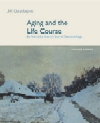1. The University of Amsterdam (http://www.pscw.uva.nl/sociosite/TOPICS/Aging.html) has a sociology of aging homepage that focuses on aging and ageism and Alzheimer's
Disease. Although this site is no longer actively maintained, it provides some
useful information on aging. Go to the website and link to Aging in a Social
Context. Then link to the article "Why Do We Age? Theories of Aging."
Read the second and third paragraphs under the second graph and answer the following
questions: - What do these paragraphs say about longitudinal and cross-sectional studies?
About uniform aging among humans?
- What is the premise of the programmed theories described in this passage?
Now look at the fifth graph, which shows that in addition to age, sex is an
important predictor of mortality. Answer the following questions: - What is the death rate per million people among men and women age 65-69?
- In general, what does the graph show about male deaths versus female deaths?
2. Go to the University of Amsterdam's website (http://www.pscw.uva.nl/sociosite/TOPICS/Aging.html)
and link to Aging in a Social Context. Select the article "Religion, Aging,
and Old Age" and answer the following questions: - What does the first table indicate about a survey respondent's age and his
or her reported religiosity? Does reported religiosity appear to increase with
age? Summarize the findings of this survey in your own words.
- Look at the third table. In general, what does this table show about the
relationship between religiosity and the health of older Americans?
3. In this chapter, you were introduced to the discipline of gerontology. To
learn more about this field, go to the Web site for the Portland Community College
(Http://www.pcc.edu/). From the homepage, click
on "Academic Programs" and then click on "List of Credit Programs."
Scroll down the page and click on "Gerontology." Read the catalogue
description, and answer these questions: - What is the employment outlook for persons certified in gerontology?
- What kind of basic knowledge is provided in core courses?
- Look at the list of courses provided. Were you surprised that psychology
courses were included? Why or why not?
4. This chapter discusses religion and aging. To learn more about religion
and aging, go to the Center for Aging-Religion-Spirituality (http://www.luthersem.edu/CARS/).
The Center for Aging-Religion-Spirituality is an independent graduate-level
institution. From the homepage, click on "Articles" and scroll down
to the article entitled, "Toward a Theology of Aging." Read the article
and answer these questions: - What are the three contexts of being able to reflect on our lives, according
to the author?
- Why does the author believe that William Glasser's Choice Theory is most
helpful in his ministry?
- What are the four psychological needs of Choice Theory?
- How do these four needs relate to aging, according to the author?
|



 2002 McGraw-Hill Higher Education
2002 McGraw-Hill Higher Education